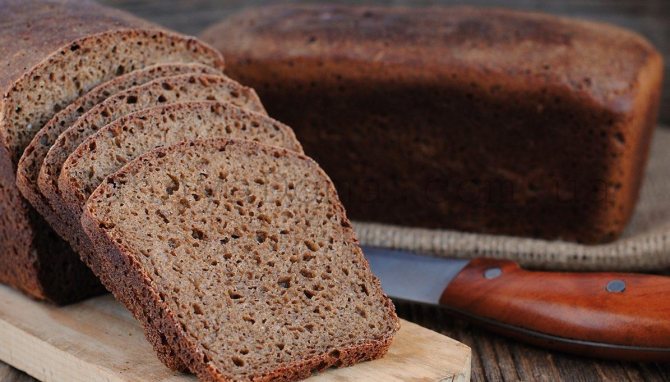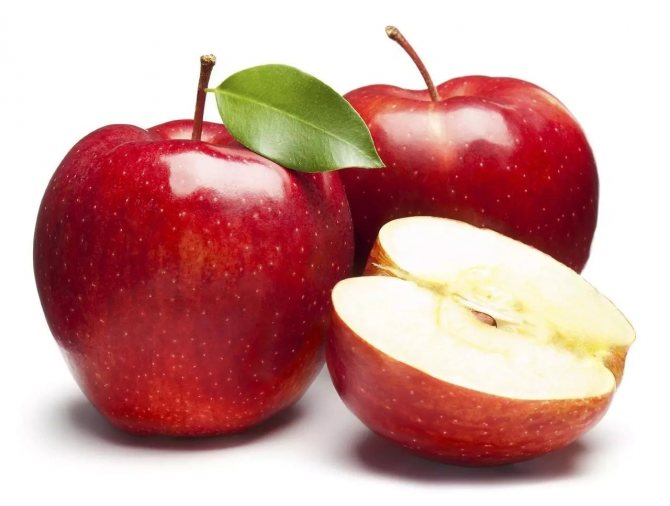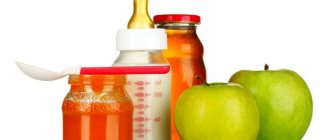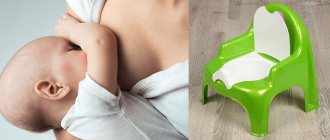The essence of the problem
Colic begins in the first days of a child’s life, passes closer to three months of age, and sometimes lasts up to six months. The baby behaves restlessly when using gas, cries, screams, and is capricious a lot. Sleep problems do not bother everyone, but they are also not uncommon. In this case, stool disturbances are observed - green mucous stool, constipation.
The main cause of colic is poor nutrition of the mother. If you exclude all potentially dangerous products, the risks will still be above 50%, but if you consume them, gassers are almost guaranteed to worry. Therefore, you need to adjust your diet and eat mostly safe, light foods.
Helpful advice! If you are on the wrong diet, eliminate a number of foods from your diet and see if your health improves or not.
Lactase deficiency
A condition in which a child either has insufficient production of the enzyme lactase by intestinal cells, or he receives too much lactose carbohydrate with milk, which he is not able to digest completely.
Symptoms : green foamy stool, loose, rumbling in the abdomen, slow weight gain or no weight gain, possibly a rash What to do : first of all, you need to pay attention to the attachment to the breast and the frequency of changing breasts during feeding, most often these two factors aggravate problems digesting lactose. Consultation with a pediatrician or gastroenterologist is also necessary. More information about lactase deficiency can be found in our article.
Allergy to cow's milk protein (CMP)
One of the most common allergens in children under 2 years of age is cow's milk protein.
Symptoms : The stool may be foamy, the color is closer to green, and there may be streaks of blood in the stool. Sometimes there is an obvious allergic rash, but there may not be one. A clear symptom of an allergy to CMP: the child begins to suckle at the breast, then drops it crying, this is repeated several times until he is half asleep. It is important to distinguish this refusal to suckle further from other types of breast refusal. Allergy to CMP is often accompanied by changes in stool.
Important! An allergy to CMP can manifest itself at any age, even if a nursing mother ate dairy products for two months and everything was fine, and in the third month the child began to show such a reaction.
What to do : If you suspect an allergy to CMP, it is recommended to completely remove dairy and fermented milk products from your diet for at least a week or ten days. This may also apply to Maria cookies, which are so often recommended as hypoallergenic, but many manufacturers use milk powder in making cookies. If there is no effect this week, then you can try to return milk to the diet. If the effect of the absence of dairy products is noticeable (the child began to worry less at the breast, cry less, bowel movements have improved), then it makes sense to reintroduce the allergen into the mother’s diet no earlier than after a month, and only gradually.
How to eat when feeding a baby?
the following rules must be adhered to:
- Drink enough water. The minimum daily intake is 2 liters, the main volume should be clean drinking water without gases. Avoid lemonade, strong tea, and coffee. Compotes and herbal decoctions are allowed, as well as fermented milk. Green and black teas, if you make them not very strong and drink not in liters, will not harm the baby.
- Introduce new products carefully, optimally, gradually. Take breaks between doses and see how your baby feels. When food allergies begin, put off new treats.
- Remove salty and fatty foods from your diet. Fish, marinades, lard (especially smoked, with spices), exotic foods are temporarily prohibited. Follow a hypoallergenic diet.
- Eat little and often. It is advisable for a nursing mother to plan 5 meals a day.
Important! Lactation teas increase milk production and do not cause unwanted reactions in the baby. Use them as needed.
How to make this period easier for the baby and his loved ones?
There are quite simple techniques that can help either reduce or prevent crying attacks. Below are the main ones.
Satisfying basic needs:
- Tactile contact: if the child cries, the first thing you do is pick him up. If that calmed him down, then he needed to know you were there.
- Feeding: If your baby continues to be fussy, offer the breast, even if he has eaten recently.
- Comfort: If close contact and feeding do not help, you need to find out if the baby is experiencing discomfort from the diaper, clothing or ambient temperature.
Frequent tactile contact and carrying of the child:
- Carrying in your arms or in a sling: when the baby is regularly close to his mother, he does not need to cry again to call her. The constant feeling of parental warmth makes babies noticeably calmer.
- Massage: A gentle circular tummy massage or back massage relaxes the baby.
- “Anti-colic position”: you can place the baby’s tummy on the inner surface of your forearm, with your legs towards your elbow, your head and chest should be placed on your hand or supported with your other hand. In this position, the tummy is gently massaged, since the legs are bent and spread apart, making it easier for the child to release gas. A slight swing or walk in this position relaxes the baby well.
- Skin-to-skin contact: Undress your baby and place him on your stomach.
Reduce irritation:
- Swaddle the baby;
- Dim the lights and remove harsh sounds;
- Turn on white noise.
What shouldn't mom do?
The main thing that a mother should do is think 100 times about whether she should eat a certain product or not. If it can cause an undesirable reaction, then no. It is not necessary to eat a lean and monotonous diet; try the following substitutions:
- Brown bread is contraindicated for breastfeeding, but whole grain bread is suitable.
- Ketchups, mustards, mayonnaises, hot and sweet sauces, and pickles are prohibited - they irritate the newborn’s intestines.
- Raw vegetables and fruits are also not allowed - in addition to vitamins, they contain a lot of fiber, which causes flatulence. Grapes, citrus fruits, cabbage, fermented foods - exclude. Vegetables are allowed, but only steamed; fruits are baked (for example, apples, pears, quinces).
- Sweets, chocolates and other desserts are not needed - they often cause increased gas formation.
- Replace beans with cheese, cottage cheese, and low-fat fish - these are also good sources of protein.
Cow's milk is a risky product, lacking antigens and often causing severe allergies. Sour milk is a more neutral option. Coffee and alcohol are prohibited for the entire feeding time.

Principles of nutrition for a nursing mother
The principles of nutrition and menu creation are based on the following features:
- You need to drink more fluid. The daily norm is at least 2 liters. 1 liter – ordinary boiled drinking water. It is allowed to drink green and black teas (without flavoring additives), fruit drinks, berry and fruit juices, fermented milk products;
- The body should not be dehydrated (in summer the amount of fluid increases);
- It is recommended to introduce new foods into the diet at certain intervals (1 product every 2 days);
- Fried foods are completely excluded;
- It is forbidden to eat salty, peppery, or with a lot of spices.
Marinades, canned food, smoked meats and semi-finished products are excluded while feeding the baby.

Compliance with the drinking regime is important during breastfeeding
Important! If a baby develops a food allergy after introducing a new product, then repeated use should be postponed for 4-6 weeks.
Foods that cause colic
You should definitely know the list of foods that cause colic in newborns - it includes a “set” that is harmless for the “common person” and unsafe for a young mother. If possible, do not consume these products at all in the first months of your child’s life.
Milk
Cow's milk is the cause of gas and allergies, so it is contraindicated in the first 5 months of life. Cook porridge in water, drink tea and milk “naked.” Fresh milk is especially dangerous for a nursing mother - it causes not only colic in the baby, but also cessation of lactation.
Alternative options are cheese, kefir, yogurt, cottage cheese. Goat's milk can be added, but it has a peculiar taste and a pungent odor.
Black bread
Brown bread, like other fermented products, is contraindicated during breastfeeding. Its use provokes increased gas formation, which leads to severe colic in the newborn. Replace it with whole grain breads - they will improve the condition of your skin, hair, and start your metabolism.
The best option for a nursing mother is bread with bran and caraway seeds. Cumin with bran, due to its unique composition, has a positive effect on the production of breast milk. Breasts tolerate the product well.

Legume family
Legumes are one of the causes of flatulence in infants. The group includes lentils and beans, peas, beans, and corn. These vegetables are extremely healthy, rich in protein, diversify the diet, add new taste to dishes, cleanse the body, and remove toxins. Beans do not cause allergies in infants, but colic is easy. Replace them with other sources of protein.
Despite their positive properties, beans should not be consumed in the first months of lactation. They negatively affect the functioning of the gastrointestinal tract, causing bloating and severe colic.
Vegetables fruits
Not all, but raw ones - they are poorly digested, cause upset in the mother and gas in the baby. Other possible side effects are poisoning and infections. So eat, but strictly after good heat treatment to increase digestibility and disinfection.
The presence of fiber in the diet of a nursing mother is mandatory. These are pears, bananas, apples, broccoli, carrots, pumpkin, cauliflower, bananas. Alternate - consuming everything at once will only cause harm. Gradually introduce cucumbers, tomatoes, peaches, and apricots. Fruits of bright colors are more likely than others to cause allergies.
Beets and cabbage are difficult to digest, so they are undesirable when feeding. It is permissible to introduce them after six months. Cooking methods: boiling, steaming, stewing, baking. Do not use oil, exclude pickled and pickled vegetables.

Sweet
Mothers can have sweets, but in limited quantities and not all. Eliminate butter, flour, fat, cream, chocolates, products with flavors, caffeine, and dyes too. Allowed:
- dried fruits;
- bitter chocolate;
- meringues;
- white marshmallows;
- Viennese, English waffles;
- biscuits;
- oriental sweets.
The main thing is not to abuse it.
Important ! Eliminate store-bought sauces completely - use sour cream, yogurt, and vegetable oil instead.
Dysbacteriosis
Pediatricians often recommend that parents test their child's stool for dysbacteriosis, meaning it is a common cause of "gas" that torments the baby. It is necessary to understand that during the period of formation of microflora, a child will definitely have dysbiosis to one degree or another, since in a newborn child the microflora is constantly changing and the balance of microorganisms is established only closer to 3-4 months. But you can pay attention to the strong excess of the concentration level of such microorganisms as Klebsiella spp, Staffilococus aureus, E. Coli hemolytica, which often cause severe discomfort to the baby.
Treatment of mother or child with antibiotics increases the risk of severe dysbiosis, so you should definitely discuss therapy with your pediatrician to maintain the baby’s intestinal microflora.
Symptoms : loose stools, maybe foamy, green, mucus. With a staphylococcal infection, there may be a pinpoint rash. What to do : Contact your pediatrician for an examination and treatment plan if necessary.
As you noticed, the manifestations of lactase deficiency, allergies and dysbacteriosis are very similar. And often these conditions can be together. Since intestinal cells are damaged during allergies, less lactase may be produced. And with a strong degree of dysbiosis, the intestines may be more sensitive to allergens. Therefore, if a child has a persistent change in stool as described and obvious anxiety, then all these conditions should be excluded.
And the last reason for crying related to the “tummy”:
Difficult infant bowel movement
Symptoms : The child may, at any time or in between, suddenly begin to cry, pull his arms and legs towards his body, strain his stomach, and push hard. Then he releases gas or walks around, and calms down almost immediately or within a minute.
This phenomenon is called dyschezia or infantile obstructed defecation. It is connected with the fact that the child feels discomfort, fullness in the intestines, but he cannot, like an adult, direct all the force of pushing to a certain place; he has to strain with his whole body, sometimes adding screaming, in order to finally push out the excess. It happens that it doesn’t work out the first time. Sometimes parents cannot bear to see the torment and actively help the child with a gas tube, thus speeding up the process. It is often said about children at this age that they “don’t poop themselves.”
What to do:
- Calm yourself and calm your child. You need to realize that nothing terrible is happening to him, that if the cry is accompanied by active straining, then the child is simply trying to help himself.
- You can give your baby the breast; as soon as he starts sucking, he will relax, and most likely the process will go easier. You can soothe with white noise (hair dryer, sound of water).
- You can press your knees towards your tummy to relax the muscles of the anterior abdominal wall.
- Sometimes vertical swinging on a fitball helps, which also has a calming effect on the child.
It’s okay if sometimes you helped your child cope with this with a gas outlet tube. The main thing is not to do this many times every day, as this interferes with the formation of the skill of independent defecation, which the child really needs. He will successfully master it in about three months.
If you are faced with the fact that your child is worried about increased gas formation, do not rush to resort to “remedies for eliminating gas” (dill water, Bobotik, Sub Simplex, Espumisan). According to studies, the effectiveness of these drugs is no more effective than placebo . It is important to contact a specialist (pediatrician, gastroenterologist) who will help find the cause of the problem, and not fight its consequences.
If all of the above reasons are excluded, and crying attacks are not associated with the activity of the gastrointestinal tract, the diet does not have an effect, then your child…
True infant colic
Symptoms : The child was calm and cheerful, but suddenly begins to cry inconsolably, scream, and press his legs to his stomach. The stomach tightens from screaming, which often leads to the idea that it is due to gas. But everyone's stomach tightens when they cry, and babies are no exception. And suddenly, after some time, the crying stops and the child is calm again. There is a phrase: “If you doubt whether your baby has colic or not, then it’s not colic.” And this is true for true colic, since they cannot be confused with anything. During an attack, the child may not respond to a change in position, to an offered breast, or to rocking. He simply becomes silent only when the attack passes.
The main criterion for diagnosing colic: “Colic is bouts of crying in a healthy child, lasting more than 3 hours in a row, more than 3 days a week, any of the last 3 weeks” [ii].
Often true colic is characterized by the traffic light rule: when the car is moving, the child is sleeping, as soon as it stops at a red light, the child begins to cry.
Causes: The modern view of the cause of colic states that this condition is not associated with damage to the gastrointestinal tract itself, but is a consequence of the child’s increased sensitivity to the processes occurring inside him. It is believed that this is a manifestation of infantile migraine.[iii] It is important to understand that this is not a disease.
If outside the attack the child is calm, gains weight normally and has a good appetite, then these crying attacks do not affect his general condition. But despite the fact that they do not affect the baby’s health, colic leads to a decrease in the quality of life of the entire family as a whole and has a very exhausting effect on the mother, since most often in the postpartum state she looks for the cause of any anxiety in the child in herself and in mother’s milk.
What to do:
What sometimes helps in the case of true colic: vertical swing on a fitball, “white” noise, skin-to-skin contact, a sudden change of environment (blow on the child, go outside).
True colic is not as common as it seems at first glance. This is a difficult period, usually from 3 weeks to 2.5 months, then the hysterics gradually fade away.
It is important for a mother to accept the fact that her child is very sensitive, and she can help him through this period with care and love.
In general, the period from 3 weeks to 3 months is very restless for the vast majority of babies. This is not always associated with colic, tummy, or stool. Children may cry from fatigue, overexcitation, discomfort, or lack of contact with an adult. It is characteristic that this begins at three weeks, since it is believed that in the first weeks after birth, babies sleep. Then they begin to be more awake and discover that there is a world around them, and mothers now exist separately, and children become more demanding of sleep and contact with parents.
How to help your baby?
Proper nutrition for the mother is the key to the well-being of the child. But be careful - even the most harmless foods can cause unwanted reactions in the first months of life. There are other recommendations:
- Place your baby correctly - he should grasp the nipple so as not to swallow air.
- Change the formula or make sure your baby doesn't overeat. Incorrectly selected artificial nutrition and gluttony are also risk factors.
- Place a warm diaper on your tummy - it will warm the sore spot and make you feel better. The fabric should not be hot.
- For prevention, place the baby on his stomach for a couple of minutes before each feeding, and hold him upright after eating.
- A light massage is also a good remedy for gas. Move clockwise, the movements should be circular and light. Perform a set of gymnastic exercises - place the child on his back, begin to straighten and bend his legs.
- Dill water soothes the stomach, normalizes digestion, and is useful for lactation. Buy a ready-made pharmacy decoction or make it yourself from dry seeds in a water bath.
There is no need to buy medications - start with diet correction and other simple methods described in the article. Use only those medications prescribed by your doctor.
Colic bothers most newborns and goes away on its own by 3-6 months. The main reason for their appearance is the malnutrition of the nursing mother. Also make sure that the baby takes the breast as needed, that the formula is suitable for him, and that there is no overeating. Medicines are usually not required.
Reaction to other foods in the mother's diet
There is a widespread belief that the diet of a nursing mother can affect increased gas formation in the child’s intestines: the mother ate something wrong, and the child has a stomach ache.
Indeed, there may be foods in your diet to which your child may have an individual reaction. But recommendations for all nursing mothers to exclude from their diet, for example, raw vegetables (cabbage, cucumbers, tomatoes), as they allegedly provoke the appearance of gas, are not justified. You should try any product and see the child’s reaction, and not refuse it “just in case.” In our articles you can learn more about the nutrition of a nursing mother and the child’s food reactions.











